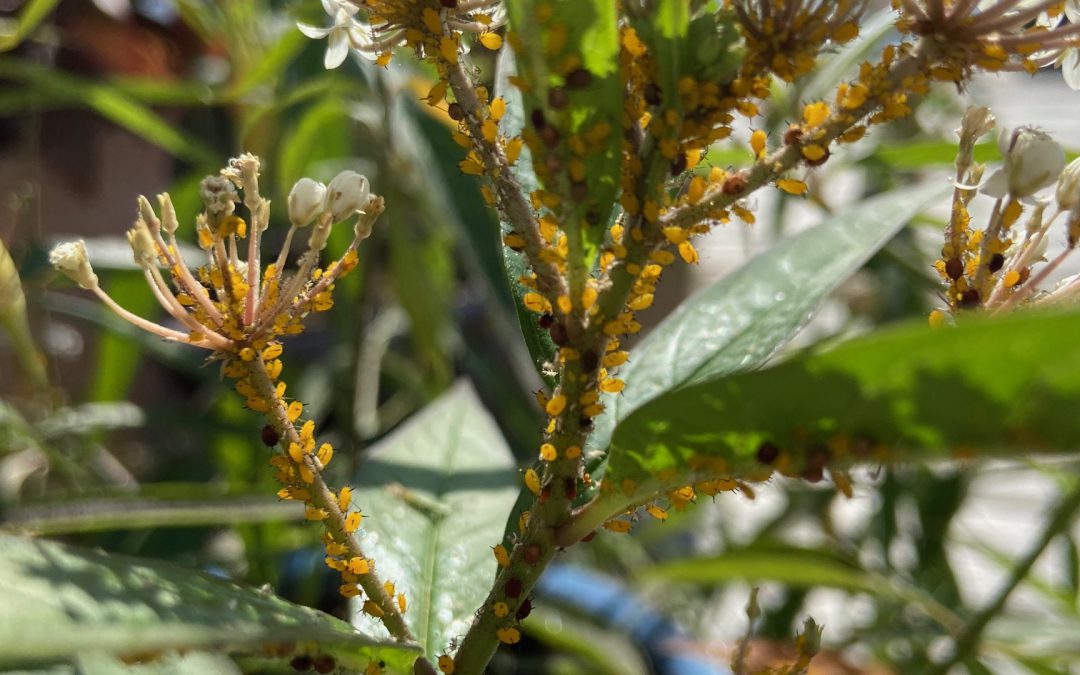
by Mary Salinas | Sep 8, 2020
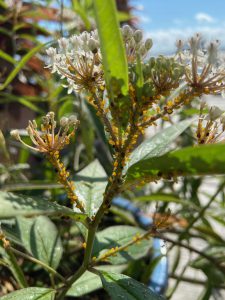
Perennial milkweed, Asclepias perennis, with oleander aphids; notice the brown aphid mummies that have been parasitized. Photo credit: Mary Salinas UF/IFAS Extension.
Milkweeds are appreciated for their beauty, but often we cultivate it for the benefit of the monarch butterflies who lay their eggs only on this plant genus. Avid butterfly gardeners want the monarch caterpillars to eat up the milkweed and become beautiful butterflies. Often instead, thousands of aphids show up and compete for space on the plants. These bright yellow aphids are known as oleander aphids.
Just how do aphids build up their populations so quickly? It seems that one day you have a small number on a few plants and then a few days later, thousands are all over your milkweed. Oleander aphids have a few advantages for quickly building their populations:
- All oleander aphids are female and do not need to mate to produce their young
- Aphids give birth to live young who immediately start feeding on the plant
- Aphids start reproducing when they are 4 to 10 days old and keep reproducing during their one-month life span
- When populations get heavy or the plant starts to decline, winged individuals are produced to migrate to new areas and plants.
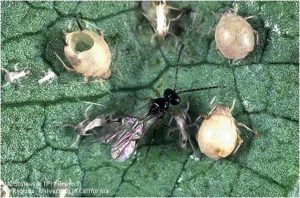
Parasitic wasp and aphid mummies. Photo credit: University of California.
What can or should you do to control this pest?
One option is to do nothing and let the natural enemies come in and do their job. One of the best is a very tiny wasp that you will likely never see. This parasitoid lays its eggs only inside aphids. The wasp larva feeds on the inside of the aphid and turns it into a round brown ‘mummy’ and then emerges when mature by making a round hole in the top of the aphid. Look closely with a hand lens at some of those brown aphids on your milkweed and you can see this amazing process. Another common predator I see in my own garden is the larvae of the hover fly or syrphid fly. You will have to look hard to see it, but it is usually there. Assassin bugs and lady beetles also commonly feed on aphids. The larvae of lady beetles look nothing like the adults but also are voracious predators of aphids – check out what they look like.
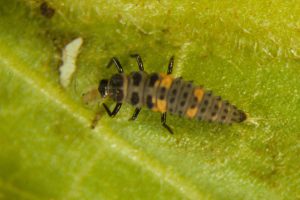
Lady beetle larva feeding on aphid on tobacco. Photo credit:
Lenny Wells University of Georgia Bugwood.org.
If you think your situation requires some sort of intervention to control the aphids, first check carefully for monarch eggs and caterpillars, keeping in mind that some may be very small. Remove them, shoo away any beneficial insects, and spray the plant completely with an insecticidal soap product. Recipes that call for dish detergents may harm the waxy coating on the leaves and should be avoided. The solution must contact the insect to kill it. Always follow the label instructions. Soap will also kill the natural enemies if they are contacted. One exception is the developing wasp in the aphid mummies – fortunately, they are protected inside as the soap does not penetrate. Oils derived from plants or petroleum can serve the same purpose as the insecticidal soap.
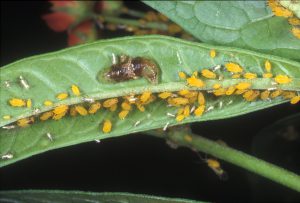
Syrphid fly larva and oleander aphids. Photo credit: Lyle Buss, University of Florida.
You also can squish the aphids with your fingers and then rinse them off the plant. If you only rinse them off, the little pests can often just crawl back onto the plant.
There are systemic insecticides, like neonicotinoids, that are taken up by plant roots and kill aphids when they start feeding on the plants. However, those products also kill monarch caterpillars munching on the plant and harm adult butterflies, bees, and other pollinators feeding on the nectar. So those products are not an option. Always read the product label as many pesticides are prohibited by law from being applied to blooming plants as pollinators can be harmed.
In the end, consider tolerating some aphids and avoid insecticide use in landscape.
Happy butterfly gardening!

by Mary Salinas | Aug 14, 2020
Mary is the Residential Horticulture Agent and Master Gardener Volunteer Coordinator for UF/IFAS Extension in Santa Rosa County. She earned a B.S. and M.S. in environmental horticulture at the University of Florida. She and her volunteers provide research-based solutions for residents with their lawns, landscapes, and gardens. Mary also oversees the educational programs, horticulture, butterflies, and volunteers at the Panhandle Butterfly House & Nature Center that has just relocated to Milton and should reopen in 2021.

Mary Salinas at the US Botanic Garden in Washington, D.C. Photo credit: Allison Ngom.
Ever since she can remember, Mary has loved plants and nurturing them. She learned how from her mother and grandmother growing up with good rich soils in Michigan. A relocation to Tampa in 1991 meant learning a whole new way to garden – new plants, new soils, and new timetables. Nearly eight years ago she moved north to Santa Rosa County to take her current position and, again, had to tweak her garden skills.
Between she and her husband they have 6 children and 4 grandchildren and are hoping for more grandchildren real soon. Family and faith are a priority. At home, Mary loves to try new crops and varieties in her vegetable garden and is passionate about growing perennials, especially native milkweeds, and watching new generations of monarch butterflies take flight. And she is fascinated with huge container gardens. Gardening is not the only activity in her life; Mary loves to kayak, cruise in the pontoon boat, hike, and volunteer as a guardian ad litem for children in foster care.
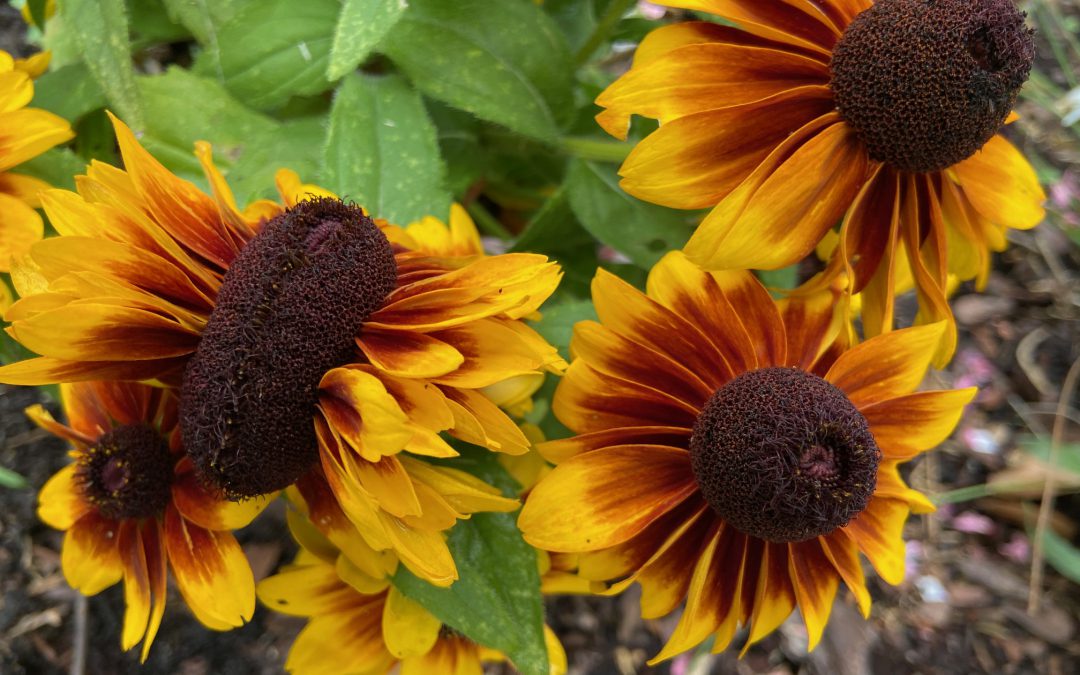
by Mary Salinas | Jul 16, 2020
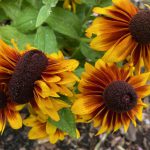
Fasciation of Rudbeckia hirta ‘Toto Rustic’. Photo credit: Mary Salinas, UF IFAS Extension.
You never know what surprises are looming in your flower gardens.
This Rudbeckia in the photo to the left sported one bloom that was so different from all the others. The disk or central portion of the inflorescence was elongated and curved back on itself and created a contorted, crazy looking bloom. And then there was a yellow squash in my garden that had a leaf growing down the length of the squash. What caused these things to happen?
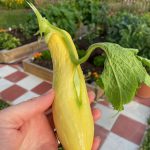
Fasciation in yellow summer squash. Photo credit: Mary Salinas, UF IFAS Extension.
This is a mutation, often genetic, but also could be caused by outside influences such as pathogens, injuries, or chemicals. Plant hormones may also play a role in this phenomenon. This mutation expresses itself as a malformation or cresting at the tip or growing point of the plant, also known as the meristem. We call this fasciation and it begins when the cells at a growing point of a plant start dividing in an uneven or asymmetrical fashion instead of the normal symmetrical pattern.
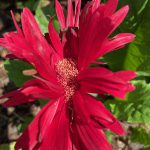
A gerbera daisy affected by fasciation. Photo credit: Mary Salinas, UF IFAS Extension.
There are some plants we embrace for their fasciation. A common one is cockscomb celosia that is prized for its showy crested inflorescence. Cacti and succulents more commonly exhibit fasciation and we can see it in some of the crested cacti.
Take a close look at what is happening in your garden and landscape. Plant biology is fascinating!
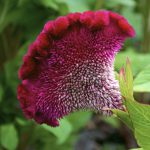
Cockscomb Celosia inflorescence. Photo credit: Lee Terilla 2008, some rights reserved.
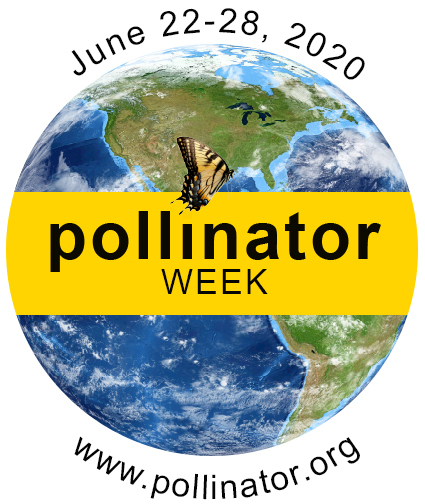
by Mary Salinas | Jun 23, 2020
For the 13th year we celebrate National Pollinator Week June 22-28 to bring awareness to the importance of our pollinators and the challenges they face. This is an opportunity to learn about ways to protect pollinators in our own landscapes. Every one of us can make a difference.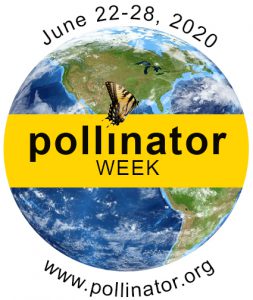
When we hear the word ‘pollinator’ most of us immediately think of honeybees. They are very important but there are so many other creatures that are important pollinators:
- Native bees – Florida alone has over 300 species of bees
- Hummingbirds – their long beaks can reach into long, tubular blooms
- Bats – they pollinate over 500 plants including banana, mango, and agave (used to make tequila)
- Beetles – considered to be a messy and minor pollinator; they pollinate the native paw paw
- Butterflies – a minor pollinator as most have long legs that keep them perched above the pollen
- Flies – pollinators of a variety of native plants
According to the USDA, 75% of flowering plants and about 35% of food crops around the globe rely on these animals for pollination. Without pollination, these plants would not reproduce or provide us food.
So, what can the average person do to make a difference?
- Plant what bees and butterflies love!
- Avoid using any insecticide unless it is absolutely necessary. Predators like assassin bugs, dragonflies and birds help to keep pests in check. Our songbirds rely on protein-rich insects (especially caterpillars) to feed their growing babies.
- Don’t treat areas where pollinators are visiting the flowers, whether in the lawn or the landscape beds.
- If you need to apply an insecticide to the lawn, mow first to remove the blooms from any weeds. Always follow the label instructions carefully.
- Avoid using a systemic insecticide on plants that bloom and attract pollinators. The insecticide can remain in plants for a long time.
Happy gardening during National Pollinator Week!
For more information:
Pollinator Partnership: Pollinator Week Activities
US Fish & Wildlife Pollinator Site
Native Insect Pollinators of the Southeastern United States brochure
Purdue University: Protecting Pollinators in Home Lawns and Landscapes
Minimizing Honey Bee Exposure to Pesticides
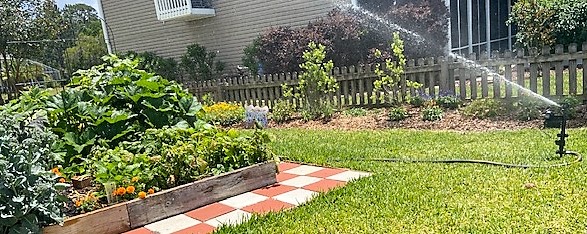
by Mary Salinas | May 14, 2020
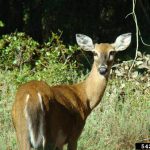
White tailed deer. Photo credit: Rebekah D. Wallace University of Georgia bugwood.org.
There doesn’t seem to be any shortage of deer in the panhandle, especially when it comes to them strolling in my yard looking for something tasty to eat. My vegetable garden suffered repeated assaults by hungry deer this past fall and winter. The garlic and cayenne pepper-based products only worked for a few days when freshly applied. I had to try something new this spring.
And my new method has worked. I purchased a motion activated high impact sprinkler that can be set to activate day or night. It has worked like a charm! There are various vendors but I purchased mine through a hardware store online for about $70. I put a splitter on my closest outdoor spigot and have a dedicated hose running to the sprinkler. This allows me to also have a regular hose for watering attached to the spigot. The hose must be turned on all the time. One problem that I am hoping to avoid this summer is that the water in the hose may get too hot in the summer heat and split the hose, so I am looking to maybe trench to keep the hose and the water inside a bit cooler.
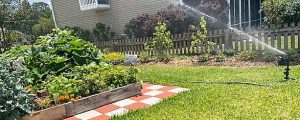
Motion activated impact sprinkler protecting the vegetable garden from ravenous deer. Photo credit: Mary Salinas, UF/IFAS Extension.
You can also choose plants that deer do not like to eat such as live oak, dogwood, muhly grass, coneflower and black-eyed Susan. However, keep in mind that when food is scarce deer will forage on plants that they normally would not eat. Southern magnolia is considered quite deer resistant but the one I planted this past winter was mostly defoliated by deer.
The University of Florida has a publication with many other strategies on controlling deer: Coping with Deer Damage in Florida.

















